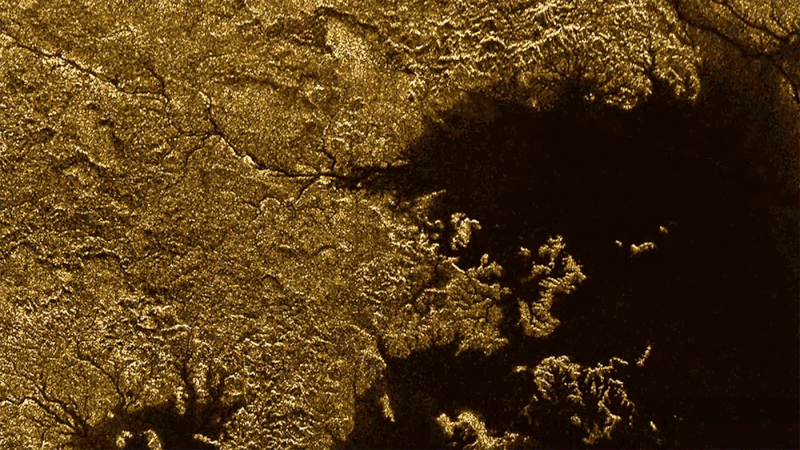
Orbiting Saturn since 2004, the Cassini spacecraft has transformed our understanding and mental image of this world and its many rings and moons. Now the Cassini mission is scheduled to end in a grand finale in 2017, but scientists will be analyzing Cassini’s data for years to come. In a new paper published August 9, 2016 in Geophysical Research Letters, researchers described how they used Cassini’s radar data to discover deep, steep-sided canyons on Saturn’s moon Titan that are flooded with liquid hydrocarbons. The researchers drew parallels on this distant moon to processes taking place at Arizona’s Grand Canyon and at Lake Powell, which straddles Arizona and Utah. NASA said in a statement:
The finding represents the first direct evidence of the presence of liquid-filled channels on Titan, as well as the first observation of canyons hundreds of meters deep.
Cassini had earlier seen sunglint off Titan’s liquid hydrocarbon lakes or “seas,” and sunglint played a role in this new discovery, too. The new paper describes how scientists analyzed Cassini data from a close pass the spacecraft made over Titan in May 2013. During the flyby, Cassini’s radar instrument focused on channels that branch out from the large, northern sea Ligeia Mare. NASA said:
The Cassini observations reveal that the channels – in particular, a network of them named Vid Flumina – are narrow canyons, generally less than half a mile (.6 km) wide, with slopes steeper than 40 degrees. The canyons also are quite deep. Those measured are 790 to 1,870 feet (240 to 570 meters) from top to bottom.
The branching channels appear dark in radar images, much like Titan’s methane-rich seas. This suggested to scientists that the channels might also be filled with liquid, but a direct detection had not been made until now. Previously it wasn’t clear if the dark material was liquid or merely saturated sediment — which at Titan’s frigid temperatures would be made of ice, not rock.
Cassini’s radar is often used as an imager, providing a window to peer through the dense haze that surrounds Titan to reveal the surface below. But during this pass, the radar was used as an altimeter, sending pings of radio waves to the moon’s surface to measure the height of features there. The researchers combined the altimetry data with previous radar images of the region to make their discovery.
Key to understanding the nature of the channels was the way Cassini’s radar signal reflected off the bottoms of the features. The radar instrument observed a glint, indicating an extremely smooth surface like that observed from Titan’s hydrocarbon seas. The timing of the radar echoes, as they bounced off the canyons’ edges and floors, provided a direct measure of their depths.
The presence of such deep cuts in the landscape indicates that whatever process created them was active for a long time or eroded down much faster than other areas on Titan’s surface. The researchers’ proposed scenarios include uplift of the terrain and changes in sea level, or perhaps both.
Valerio Poggiali of the University of Rome, a Cassini radar team associate and lead author of the study, commented:
It’s likely that a combination of these forces contributed to the formation of the deep canyons, but at present it’s not clear to what degree each was involved.
What is clear is that any description of Titan’s geological evolution needs to be able to explain how the canyons got there.
The scientists pointed to earthly examples of both of these types of canyon-carving processes. The Grand Canyon in Arizona, located along the Colorado River, is an example of uplift powering erosion. In other words, the terrain’s rising altitude caused the river to cut deeply downward into the landscape over the course of several million years.
Meanwhile, the human-made reservoir Lake Powell – also located along the Colorado River – is an example of canyon formation driven by variations in water level. NASA explained that, when the water level in the Lake Powell reservoir drops, it increases the river’s rate of erosion.
Alex Hayes, a Cassini radar team associate at Cornell University, Ithaca, New York, and a co-author of the study, said:
Earth is warm and rocky, with rivers of water, while Titan is cold and icy, with rivers of methane. And yet it’s remarkable that we find such similar features on both worlds.
Read more via NASA’s Jet Propulsion Laboratory
Bottom line: We knew Saturn’s moon Titan had lakes or “seas” filled with liquid hydrocarbons. Now Cassini has also discovered liquid-filled canyons on Titan, likely created in processes similar to those on Earth.











